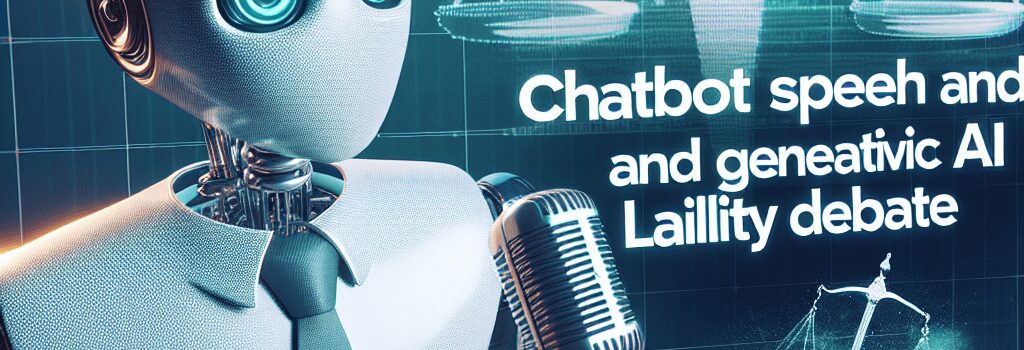Chatbot Speech and Generative AI Liability Debate

As Character.AI defends itself in a Florida federal lawsuit alleging its chatbots’ outputs contributed to a teenager’s suicide, the company has advanced a novel First Amendment argument: that chatbot-generated text constitutes “pure speech” deserving the highest level of constitutional protection. Legal experts warn the ruling could reshape free-speech jurisprudence for generative AI, upend product liability standards, and influence global regulatory approaches.
Background of the Lawsuit
In April 2025, the mother of 17-year-old Sewell Setzer filed a wrongful-death suit against Character Technologies (the creator of Character.AI), claiming that prolonged exposure to certain AI-generated dialogues caused her son to become deeply depressed and ultimately take his own life. In a motion to dismiss, Character Technologies asserted that:
- All recipients have a constitutional right to receive information and ideas, regardless of the speaker’s identity.
- AI-generated content qualifies as “pure speech” under the First Amendment.
- Dismissing or penalizing such speech would produce a chilling effect on C.AI and the broader generative AI industry.
Opposing counsel argues that LLM outputs lack human intent and thus fall outside First Amendment shielded expression. They cite a 1985 Eleventh Circuit ruling that a talking cat named “Blackie” was not a person, underscoring that non-human entities cannot claim speech rights.
Technical Underpinnings of LLM Speech Generation
Large language models (LLMs) like those behind Character.AI typically employ transformer architectures with billions of parameters. For instance, Character.AI’s 70-billion-parameter model is trained on over 1 trillion tokens of web-scraped text, fine-tuned via reinforcement learning from human feedback (RLHF) to produce conversational outputs.
Key technical elements include:
- Tokenization: Text is broken into subword units (tokens) via byte-pair encoding (BPE) before being processed.
- Self-Attention Mechanisms: Enable the model to weigh context across long sequences, critical for maintaining coherent multi-turn dialogues.
- Probabilistic Sampling: Chatbot responses are generated by sampling from a softmax distribution over the vocabulary, controlled by temperature and top-k/top-p hyperparameters.
- Safety Layers: Post-training classifiers and rule-based filters detect and suppress disallowed content.
Because these generation steps rely on complex matrix multiplications in GPU or TPU clusters, human designers cannot fully trace or predict each response, complicating attempts to attribute intent or foresee specific outputs.
Legal Precedents in AI and Free Speech Law
Several recent cases have intersected AI and First Amendment doctrines:
- Twitter v. Taamneh (2024) – The Supreme Court limited platform liability for third-party content, emphasizing Section 230 protections rather than constitutional speech rights.
- In re Blackie (1985) – The Eleventh Circuit denied personhood to a talking cat, illustrating courts’ reluctance to extend speech rights to non-humans.
- Doe v. Meta (2023) – Plaintiffs sought to hold Meta liable for self-harm content on Instagram, but the court found that content moderation choices fell under traditional publisher immunity.
Character.AI’s motion to dismiss hinges on expanding the “right to receive information” to cover AI-generated speech, bypassing intent-based tests historically used to demarcate protected expression.
Policy Implications and Global Regulatory Trends
A ruling that categorically extends First Amendment protections to generative AI outputs would have sweeping implications:
- U.S. Legislation: It could complicate the passage of the proposed AI Bill of Rights or the Algorithmic Accountability Act, by creating a near-absolute speech shield for AI services.
- International Models: The EU’s AI Act classifies high-risk systems and mandates stricter oversight for mental-health or child-facing applications.
- National Security: Agencies like the FTC and DOJ have expressed concern that unregulated AI speech could facilitate foreign influence operations—precisely the scenario Character.AI warns against in its filings.
Expert Opinions and Industry Reactions
Camille Carlton, policy director at the Center for Humane Technology, testified as a technical expert that recognizing AI outputs as protected speech would effectively grant chatbots other rights akin to corporate personhood.
University of Colorado Law Professor Jane Estelle notes, “Our First Amendment jurisprudence has always centered on human volition. AI lacks consciousness; its ‘speech’ is generated by statistical correlation, not genuine belief. Courts must avoid creating a pseudo-sentient class of rights-bearing machines.”
Emerging Legislative and Judicial Developments
Since the Florida hearing in May 2025, several developments are worth noting:
- The Senate Commerce Committee issued a bipartisan Report on AI Liability urging clarification on publisher vs. speaker immunities for AI systems.
- Last month, the California Assembly introduced a bill requiring AI platforms to implement youth safety standards—including threshold filters for self-harm content—potentially preempting constitutional defenses.
- Multiple circuit courts are weighing similar immunity questions, raising the prospect of a Supreme Court decision by late 2026.
Conclusion: Defining AI Speech in the Digital Age
The outcome of this motion to dismiss will either uphold traditional First Amendment boundaries—anchored in human speakers and corporate entities—or chart a new path where generative AI outputs enjoy near-absolute speech protection. For grieving families like the Garcias, and for the broader AI industry, the stakes could not be higher.